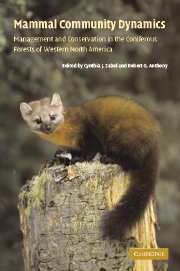 Mammal Community Dynamics
Mammal Community Dynamics Published online by Cambridge University Press: 15 December 2009
Snowshoe hare (Lepus americanus) and lynx (Lynx canadensis) populations show 9- to 11-year cycles throughout the boreal coniferous forests of Canada and Alaska. Lynx cycles, recorded in Hudson Bay trapping records covering many decades, have been analyzed by population ecologists interested in understanding the mechanisms underlying the cycle (Royama 1992, Ranta et al. 1997). Long-term records of hare cycles are less common but there have been two major field programs that have measured demographic changes over at least one full cycle. This includes the work based at Rochester, Alberta by Lloyd Keith and co-workers (Keith et al. 1984, Keith 1990) and our work based at Kluane, Yukon (Krebs et al. 1986, Sinclair et al. 1988, Krebs et al. 1995). These field studies have established the demographic mechanisms that drive changes in hare numbers and have tested mechanistic hypotheses about factors that stop population increase and cause the hare population decline (Keith 1990, Krebs et al. 2001b).
It is clear that the lynx and hare are tightly linked (Royama 1992, Stenseth et al. 1998). Lynx show strong functional and numerical responses to changes in hare density (Keith et al. 1977, O'Donoghue et al. 1998). In turn, the dominant proximate cause of hare mortality is predation (Keith et al. 1984, Boutin et al. 1986) with lynx being one of a suite of hare predators.
To save this book to your Kindle, first ensure no-reply@cambridge.org is added to your Approved Personal Document E-mail List under your Personal Document Settings on the Manage Your Content and Devices page of your Amazon account. Then enter the ‘name’ part of your Kindle email address below. Find out more about saving to your Kindle.
Note you can select to save to either the @free.kindle.com or @kindle.com variations. ‘@free.kindle.com’ emails are free but can only be saved to your device when it is connected to wi-fi. ‘@kindle.com’ emails can be delivered even when you are not connected to wi-fi, but note that service fees apply.
Find out more about the Kindle Personal Document Service.
To save content items to your account, please confirm that you agree to abide by our usage policies. If this is the first time you use this feature, you will be asked to authorise Cambridge Core to connect with your account. Find out more about saving content to Dropbox.
To save content items to your account, please confirm that you agree to abide by our usage policies. If this is the first time you use this feature, you will be asked to authorise Cambridge Core to connect with your account. Find out more about saving content to Google Drive.